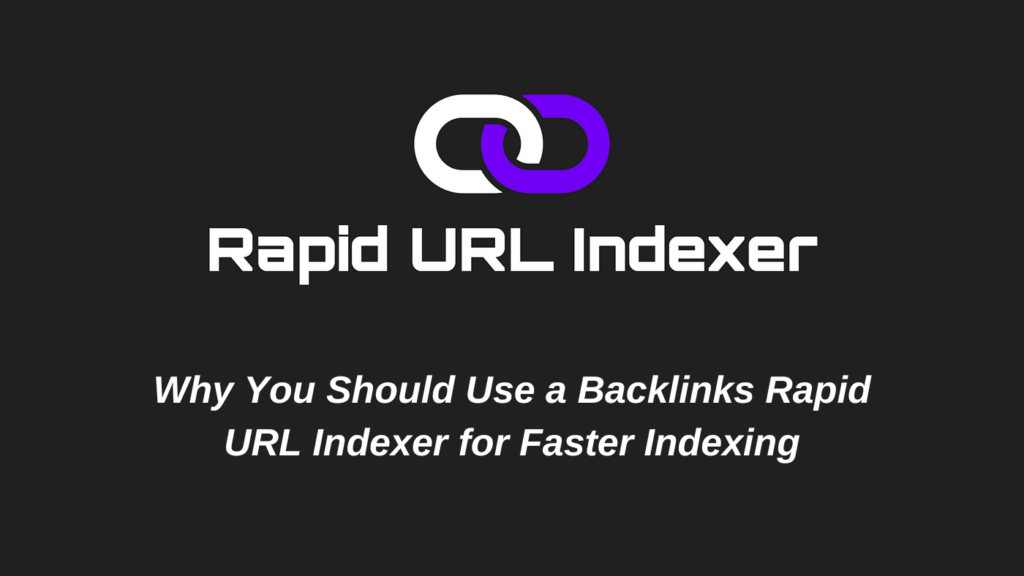Why You Should Use a Backlinks Rapid URL Indexer for Faster Indexing

Website indexers are effective tools that can greatly increase the exposure of your website in search engine rankings. We’ll go to the backlinks rapid URL indexer for faster indexing, and how to use them effectively.
Now that you know the specifics of these crucial resources, you can see how they can raise the search engine ranks of your website.
What Is the Procedure for Backlinks Indexing?
Google crawls webpages, evaluates their content, and adds them to its enormous database as part of the indexing process. The Googlebot, an automated web crawler, navigates via links on pages to find fresh and updated content.
Following crawling, a page is examined and perhaps added to Google’s index, which forms the foundation for search results. Trying to get their pages indexed presents several difficulties for website owners.
Several prevalent problems include:
- Slow crawl speeds
- Huge, multi-page websites
- Fresh sites with scant inbound links
- Technical SEO issues (such as banning robots.txt and noindex tags)
- Poor or duplicate content
These issues can make a website less visible in search results by delaying or preventing pages from being indexed completely.
How Can Search Engine Visibility Be Increased by Backlinks Rapid URL Indexer?
Website indexers can improve visibility in search results by speeding up the crawling and indexing process. How they operate is by:
- Sending URLs to search engines directly
- Sending pings to search engines to inform them of fresh or modified content
- Making XML sitemaps to facilitate the finding of material
- Keeping track of indexing progress and generating reports
- Website owners can maximize the speed at which their material is found and indexed by using Google Backlink Rapid URL Indexers. This could result in higher organic traffic and faster ranking gains.
What Makes Backlinks Rapid URL Indexer the Greatest Indexing Tool?

Because it provides a special blend of features, performance, and affordability, Rapid URL Indexer is regarded as the best indexing tool. With its unique pricing structure and great success rate, Rapid URL Indexer distinguishes itself from other indexing services. To optimize URL submission for quicker indexing, do the following:
- Making original, high-quality content a priority
- Make certain that search engines can access the URLs that are submitted
- Making use of tidy, informative URLs
- Submitting separate URLs and XML sitemaps
- Resolving any technical SEO problems before submission
- Concentrating on pages with fresh content or recent changes
Your chances of indexing quickly and successfully can be increased by adhering to these guidelines.
Which Common Errors in Indexing Should You Steer Clear of?
Avoid the following common indexing errors:
- Submitting redundant or low-quality content; depending too much on indexing tools at the expense of raising the caliber of the site
- Putting off fixing technical SEO problems that hinder indexing
- Submitting URLs that have robots.txt or noindex tags disabled
- Failing to keep track of indexing status and outcomes
- Using unscrupulous or spammy indexing techniques
By avoiding these blunders, you may increase the success rate of your indexing and preserve a positive connection with search engines.
Can Backlinks Be Indexed Using Rapid URL Indexer?

Sure, you can use a rapid URL indexer to index backlinks, and doing so will help your SEO efforts a lot. The authority and position of your website in search engines are mostly dependent on backlinks. Search engines will identify the authority of high-quality backlinks sooner when they are swiftly indexed, which could improve your website’s ranks.
When Backlinks Rapid URL Indexer is used, it guarantees that these important links are indexed and crawled more quickly than they would be through normal indexing. If you’ve recently added new backlinks and want to quickly examine how they affect your rankings, this is a very helpful way. It expedites the exposure of your link-building endeavors, guaranteeing that search engines can assess and commend your website.
How Is Indexing Success Measured and Tracked?
Success with indexing can be monitored and measured by:
- Viewing the Index Coverage report from Google Search Console
- Monitoring indexed page counts with third-party SEO tools
- Examining the dates that search engines have cached important pages
- Trends in organic search traffic analysis
- Analyzing indexing tool statistics and analytics; tracking keyword ranks for recently indexed content
Evaluate these indicators regularly to determine how well your indexing efforts are working and make any necessary adjustments to your plan.
Are Search Engine Guidelines Followed by Backlinks Indexers?
Since backlinks inform search engines like Google that your website is reliable and authoritative, they are an essential component of any effective SEO plan. Backlinks must first be indexed to affect your search engine rankings. A backlink indexing rapid URL indexer becomes crucial at this point.
Your backlinks will be indexed more quickly if you use a Google backlink rapid URL indexer, which will enable search engines to find them more quickly. Your SEO success may be hampered by the normal time it takes for Google’s bots to naturally crawl and index backlinks. You may ensure that these connections are crawled quickly and have an immediate effect on your site’s rankings by using a backlinks rapid URL indexer.
Using a rapid URL indexer guarantees that Google will identify your links instantly, regardless of whether you’ve developed strategic relationships with local websites or obtained fresh backlinks from high-authority sites. Your SEO efforts will benefit greatly from this, as you’ll see an increase in traffic, ranks, and visibility in search engine results. To put it briefly, a rapid URL indexer that builds backlinks is a crucial tool for expediting the process of establishing links.
How Are Websites with Thousands of Pages Handled by Indexing Tools?
Tools for indexing websites with thousands of pages are handled by:
- XML sitemap processing, bulk URL submission options, and API connectors for automated submissions
- Using prioritization algorithms, concentrate on the most crucial pages
- Crawl rate limitations prevent the site’s servers from being overloaded.
Getting URLs indexed is the main goal of website indexers; getting them removed is not. Utilize Google Search Console’s URL removal tool, properly implement no index tags, or utilize robots.txt directives to remove undesired URLs from search results.
If you have a big website with plenty of pages to index, go for an indexing tool like Rapid URL Indexer that provides scalable solutions.


